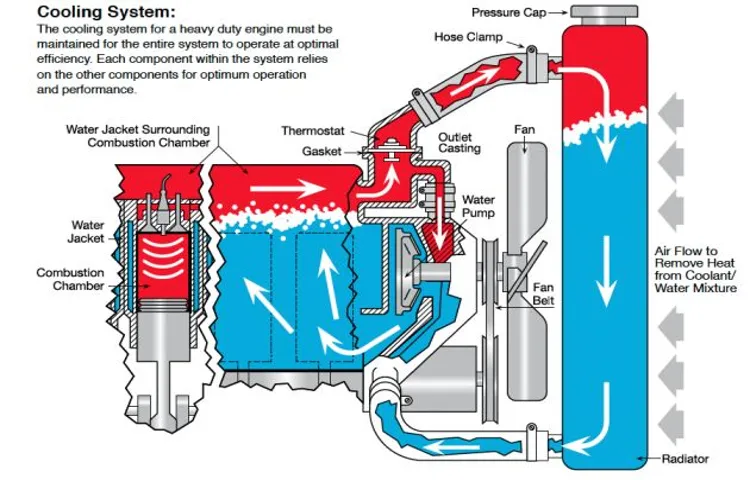Hey there! Have you ever wondered how your car’s engine stays cool and doesn’t overheat? Well, the secret lies in the coolant that flows through it. Understanding how coolant flows through an engine is essential in ensuring that your vehicle runs smoothly and efficiently. So, buckle up and let’s dive into the world of engine cooling! Imagine your car’s engine as a heart and the coolant as its lifeblood.
Just like our bodies rely on blood to transport oxygen and nutrients, an engine relies on coolant to regulate temperature and prevent overheating. Without proper cooling, an engine can suffer from serious damage, leading to costly repairs. But how does coolant actually flow through an engine? Think of it as a continuous cycle.
The coolant starts its journey in the radiator, where it is cooled down by passing air or a fan. From there, it travels through a series of hoses and channels, entering the engine block and cylinder heads. Once inside the engine, the coolant absorbs heat generated by the combustion process and carries it away.
It then circulates back to the radiator, where it is cooled once again, and the cycle continues. This constant flow of coolant ensures that the engine stays at an optimal temperature, preventing any potential damage. To aid in the flow of coolant, engines are equipped with a water pump.
This pump is driven by a belt connected to the engine and acts as the heart, pushing the coolant throughout the system. The water pump plays a crucial role in maintaining the engine’s temperature and ensuring that the coolant flows smoothly. So, why is it important to understand how coolant flows through an engine? Well, it allows you to have a better grasp of your vehicle’s cooling system, enabling you to identify any potential issues and take appropriate action.
It also emphasizes the importance of regular maintenance, such as flushing and replacing the coolant, to ensure optimal performance. Now that we have a basic understanding of how coolant flows through an engine, we can appreciate the intricate workings of this essential component. From the radiator to the water pump, every part plays a vital role in keeping your engine cool and preventing any overheating mishaps.
Table of Contents
Why is Coolant Flow Important?
One of the most important aspects of an engine’s cooling system is the flow of coolant. Coolant, also known as antifreeze, plays a crucial role in preventing the engine from overheating and maintaining optimal operating temperatures. So, which way does coolant flow through an engine? Well, the flow of coolant starts at the radiator, where it is pumped into the engine through the upper radiator hose.
Once inside the engine, the coolant passes through passages in the engine block and cylinder heads, absorbing heat as it goes. It then flows back to the radiator, where it is cooled down before being circulated through the engine again. This continuous flow of coolant ensures that the engine stays cool and prevents any potential damage caused by overheating.
So, the next time you’re wondering why coolant flow is important, remember that it is the key to maintaining your engine’s optimal temperature and preventing costly repairs.
Coolant as an Engine’s Lifeline
coolant flow, engine’s lifeline, importance of coolant flow Coolant flow is crucial for the functioning of an engine, serving as its lifeline. It plays a vital role in regulating the engine’s temperature, preventing it from overheating. But why is coolant flow so important? Well, picture this: imagine you’re running a marathon, and you have no access to water to keep yourself hydrated.
Pretty tough, right? Well, the same goes for an engine without coolant flow. Coolant acts as the engine’s “water,” keeping it cool and preventing it from breaking down under the intense heat generated during operation. Without proper coolant flow, an engine runs the risk of overheating, which can lead to irreversible damage and costly repairs.
So, next time you think about skipping that coolant flush or neglecting your regular maintenance, remember that coolant flow is the engine’s lifeline, and it’s a crucial part of keeping your vehicle running smoothly. Don’t let your engine run dry – keep the coolant flowing!

Preventing Overheating
coolant flow, preventing overheating
Optimizing Engine Performance
coolant flow, engine performance, optimizing engine performance
The Role of the Water Pump
Have you ever wondered how the coolant flows through an engine? Well, the water pump plays a crucial role in this process. Think of the water pump as the heart of the engine, pumping the coolant throughout the system. The way the coolant flows depends on the design of the engine.
In most engines, the coolant flows from the radiator to the engine block through the top hose. From there, it circulates through the engine, absorbing heat along the way. The hot coolant then returns to the radiator through the bottom hose, where it is cooled down before repeating the cycle.
So, next time you start your engine, remember that it’s the water pump that keeps the coolant flowing, ensuring that your engine stays cool and performs optimally.
Location and Function
water pump In the industrial world, water pumps play a vital role in many applications. They are responsible for the movement of water from one location to another, and they are found in a variety of industrial settings, including manufacturing plants, construction sites, and agricultural fields. The location of the water pump depends on its function.
For example, in a manufacturing plant, the water pump may be located in a central location, such as a pump house or utility room, to ensure efficient distribution of water throughout the facility. Similarly, on a construction site, water pumps are often placed strategically to supply water to various parts of the site. The location of the water pump is important to ensure that water is delivered to the desired areas and that the pump can be easily accessed for maintenance and repairs.
Regardless of their location, water pumps are essential for maintaining processes and operations that rely on a steady supply of water. Whether it’s for cooling equipment, irrigating crops, or transporting water for various uses, the water pump is an indispensable component in many industrial applications.
Types of Water Pumps
Water pumps play an essential role in various applications, from residential to industrial settings. Their main function is to move water from one place to another, ensuring a steady flow and distribution. Whether it’s for irrigation, drainage, or water supply, these pumps are essential to maintain the proper functioning of different systems.
Imagine a water pump as the heart of a plumbing system, pumping water throughout the network of pipes to ensure that every faucet, shower, or toilet has a steady supply of water. Without a water pump, these systems would be ineffective, leading to a lack of water pressure and disrupted functionality. Water pumps come in different types, such as centrifugal pumps, submersible pumps, and jet pumps, each catering to specific needs and requirements.
So the next time you turn on a faucet or take a shower, remember the vital role played by the water pump in making it all possible.
How Coolant Flows Through an Engine
Ever wonder how coolant flows through an engine? Well, it’s actually a pretty fascinating process. When your engine starts to heat up, the coolant, also known as antifreeze, begins to circulate. It’s pumped through the engine block by the water pump.
As it moves through the engine, it absorbs heat from the various components, such as the cylinders and the cylinder walls. This helps to prevent the engine from overheating. Once the coolant has absorbed the heat, it travels to the radiator, where it is cooled down by a fan and released back into the engine to repeat the process.
So essentially, the coolant flows in a continuous loop, constantly cooling and protecting the engine from overheating. Pretty cool, huh?
The Inlet Manifold
coolant flow, inlet manifold, engine coolant, engine cooling system. The inlet manifold plays a crucial role in the engine cooling system and ensures that coolant flows smoothly and effectively throughout the engine. Think of it as the bloodstream of the engine, delivering the right amount of coolant to each part that needs to be cooled.
So, how exactly does coolant flow through an engine? Firstly, let’s understand what coolant is. Coolant is a mixture of water and antifreeze that helps in maintaining the engine at an optimum temperature and prevents it from overheating. It absorbs the excess heat generated by the combustion process and carries it away from the engine.
The process begins when the coolant is pumped by the water pump from the radiator into the inlet manifold. The inlet manifold is a network of passages that connects the intake ports on the engine to the intake manifold. It is usually made of metal and is designed to distribute the coolant evenly to each cylinder of the engine.
Once inside the inlet manifold, the coolant flows through small pipes or passages known as coolant pathways. These pathways are specifically designed to allow the coolant to come into contact with the various parts of the engine that need cooling, such as the cylinder walls, cylinder heads, and valves. As the coolant flows through the engine, it absorbs the heat from these parts and carries it back to the radiator.
The radiator then cools the coolant by passing it through a series of tubes where it is exposed to the cooler air outside the engine. But how does the coolant flow through the inlet manifold? It is primarily driven by the pressure created by the water pump. The water pump creates a flow of coolant that is forced through the inlet manifold, ensuring that it reaches every part of the engine that needs to be cooled.
To ensure efficient cooling, the design of the inlet manifold is of utmost importance. It should be designed in such a way that the coolant flows smoothly through it, without any restrictions or blockages. This is essential as any hindrance in the coolant flow can lead to overheating of the engine and potential damage.
The Cylinder Head
cylinder head, coolant flow, engine, overheating, temperature control, gasket, Have you ever wondered how the coolant in your car’s engine manages to keep it from overheating? Well, it’s all thanks to the cylinder head and its role in ensuring a smooth flow of coolant throughout the engine. Think of the cylinder head as the brain of the engine, controlling the temperature and making sure it doesn’t reach dangerous levels. The cylinder head sits on top of the engine block and forms the combustion chamber where the fuel is burned.
It is made from a strong material like cast iron or aluminum to withstand the high temperatures generated by the combustion process. One of the most important functions of the cylinder head is to provide a pathway for the coolant to flow through the engine. The coolant, a mixture of water and antifreeze, is circulated through the engine to absorb the heat generated by the combustion process.
So how does the coolant flow through the engine? Well, it starts at the radiator, which acts as a cooling system. The coolant is pumped by the water pump through hoses and tubes into the cylinder head. It enters the engine block through small channels, known as water jackets, which are cast into the head and block.
Once inside the engine block, the coolant flows around the cylinders, absorbing the heat generated by the combustion process. It then travels back up to the cylinder head, where it circulates around the valves and covers the spark plugs. As the coolant absorbs more heat, it rises in temperature and expands, creating pressure within the cooling system.
To prevent any leaks or blowouts, the cylinder head has a gasket between it and the engine block. This gasket forms a tight seal to ensure that the coolant doesn’t leak out and that the combustion gases don’t enter the cooling system. The gasket also helps to maintain the pressure within the system, allowing for efficient cooling.
In conclusion, the cylinder head plays a crucial role in controlling the temperature of your car’s engine. By providing a pathway for the coolant to flow through the engine and preventing any leaks, it ensures that the engine stays cool and runs smoothly. So the next time you’re driving, remember to thank your cylinder head for keeping your engine from overheating!
The Engine Block
Coolant flow through an engine is crucial for maintaining optimal operating temperature and preventing overheating. Think of the engine as the heart of a car, and coolant as the blood that circulates through the engine block. Just like blood carries nutrients and oxygen to various parts of the body, coolant carries heat away from the engine to keep it cool.
The coolant flows through the engine in a continuous loop, starting from the radiator, passing through the engine block, and back to the radiator. This process is facilitated by the water pump, which pumps the coolant through the system. As the coolant passes through the engine block, it absorbs excess heat generated during the combustion process.
It then travels back to the radiator, where it is cooled down by air passing through the radiator fins or by the cooling fan. This cooled down coolant is once again pumped back into the engine block to repeat the cycle. This constant circulation of coolant helps maintain the engine temperature within the desired range, preventing any damage or decrease in performance caused by excessive heat.
Keeping a close eye on coolant levels and ensuring proper circulation is essential for the overall health and longevity of the engine.
Coolant Flow Direction
One question that often comes up when discussing engines is which way does coolant flow through an engine? Well, the answer to that question is actually quite straightforward. Coolant flows through the engine in a closed loop system, being pushed through the various components by the water pump. The coolant absorbs heat from the engine as it circulates, helping to regulate its temperature and prevent it from overheating.
So, imagine the coolant as a kind of blood, circulating through the engine and carrying away the heat, just like our body’s blood carries away waste. It’s an essential part of keeping the engine running smoothly and preventing any damage from excessive heat. So, the next time you’re wondering how coolant flows through an engine, just picture it as a vital system of circulation, keeping everything cool and running efficiently.
Inlet vs Outlet
coolant flow direction
Understanding the Water Pump’s Rotation
water pump’s rotation, coolant flow direction
Conclusion: Proper Coolant Flow for Optimal Engine Performance
So, after delving into the intricacies of coolant flow through the engine, we have come to the conclusion that it all boils down to one simple direction: Circularity. Yes, dear reader, coolant flows through the engine in a glorious loop-de-loop, an endless waltz of heat absorption and dissipation. Think of it as a graceful ballet, with the coolant pirouetting its way through the engine, collecting unwanted heat like a smitten dance partner, and then elegantly twirling and curving its way back to the radiator to be cooled off, ready to start the dance all over again.
But, let’s not forget the stars of the show – the water pump and the thermostat. The water pump, a true engine maestro, directs the flow of coolant with its rhythmic pumping action, ensuring that it cascades through the engine’s nooks and crannies effortlessly. And the thermostat, the engine’s conductor, acts as the gatekeeper, deciding when it’s time to unleash the coolant’s cooling powers.
Like a wise old sage, it opens and closes, allowing the perfect amount of coolant to flow, conducting the symphony of temperature regulation. In this grand performance, it becomes clear that coolant flow is not just a one-way street, it’s a highly orchestrated dance that keeps our engines running smoothly. So, the next time you start your engine, take a moment to appreciate the artistry of coolant flow and marvel at the engineering masterpiece that keeps everything cool.
And remember, dear reader, coolant flow is not just a concept, it’s a beautifully choreographed masterpiece that keeps our engines from overheating and ensures that our vehicles keep dancing through the roads of life.
FAQs
Which way does coolant flow through an engine?
Coolant flows from the radiator into the engine block through the upper radiator hose, circulates through the engine to absorb heat, and then returns to the radiator through the lower radiator hose.
How does the coolant flow in a car’s cooling system?
The coolant is pumped by the water pump from the engine to the radiator, where it is cooled down before being pumped back into the engine through the thermostat.
Is it possible for coolant flow to reverse in an engine?
Yes, it is possible for coolant flow to reverse in an engine if there is a malfunctioning water pump, a blocked radiator, or a faulty thermostat.
What happens if coolant flow is blocked in an engine?
If the coolant flow is blocked, the engine can overheat, causing potential damage to the engine components and leading to engine failure.
Can proper coolant flow prevent engine overheating?
Yes, proper coolant flow is essential for cooling the engine and preventing overheating. It helps to regulate the engine temperature and dissipate heat efficiently.
How can I check the coolant flow in my car’s engine?
To check the coolant flow, start the engine and let it warm up. Then, carefully touch both the upper and lower radiator hoses. If both hoses are hot, it indicates proper coolant flow.
What are the signs of poor coolant flow in an engine?
Signs of poor coolant flow include engine overheating, a fluctuating temperature gauge, coolant leaks, gurgling sounds in the cooling system, and reduced heating performance in the cabin.


